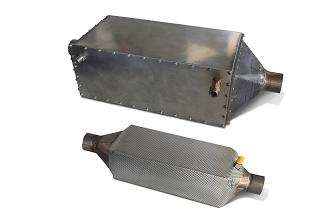BMW (Car maker) has a Turbosteamer and Thermoelectric Generator (TEG) projects. They are focused on generating electric current from waste heat to improve overall engine efficiency, but each project follows a different approach and time frame. There is great potential for considerable fuel savings if the electrical energy required by all of the systems in an automobile can be produced using waste heat rather than relying solely on the vehicle’s generator.
In 2005, BMW labs tested the turbosteamer on four-cylinder petrol engines and the dual system boosted the performance of these engines by 15 percent.
The turbosteamer today: smaller and simpler
Research project Turbosteamer: comparison of the heat exchanger generation 1 (top) and generation 2 (bottom).
In order to further develop the system for use in series production, attention was given to reducing the size of the components and making the system simpler to improve its dynamics and achieve an optimized cost-benefit ratio. Thus researchers focused on designing a component having only one high-temperature circuit.
“We have made great progress toward achieving our original goal, which was to develop a system ready for series production within about ten years. When completed, this system will weigh only 10 kg to 15 kg and will be capable of supplying all of the electrical energy required by an automobile while cruising along the motorway or on country roads,” says Ringler. Under these conditions the developers are sure that the average driver will be able to reduce fuel consumption by up to 10 percent on long-distance journeys.
Thermoelectric generator
Considerable progress has also been made in the Thermoelectric Generator (TEG) Project that is also focused on series production of an energy-saving component. The two alternative systems developed to date differ in their positioning in the vehicle – one unit is designed for the exhaust system, while the other is intended for the exhaust gas recirculation system. The development phase focused on integrating units in the exhaust system has led to considerable component improvements, especially in terms of weight and size.
One principle – three generations
The first step taken by engineers was to integrate a thermoelectric generator in the exhaust system to generate electrical current. The first such system was shown to the public in 2008 and delivered a maximum of 200 watts, which was relatively low in terms of power efficiency. But the use of new materials and improvements in the weight and size of the TEGs led to rapid new developments, so that the latest generation of TEGs installed in the exhaust are capable of generating 600 watts of electrical power, and it will not be long before the goal of 1,000 watts is reached as research progresses. The current prototype – a BMW X6 – was built as part of a development project funded by the US Department of Energy.
Then in 2009, the BMW Group unveiled an alternative development in this project. Rather than installing the TEG as a separate module in the exhaust system underneath the vehicle, engineers decided to integrate the TEG in the radiator of the exhaust gas recirculation system. In this configuration, customer testing has shown that 250 watts can be generated while CO2 emissions and fuel consumption are reduced by 2 percent at the same time.
What’s more, this energy recovery system offers some interesting added benefits, such as supplying the engine or passenger compartment heating with additional warmth during cold starts. And the thermoelectric generator is the ideal counterpart for BMW EfficientDynamics Brake Energy Regeneration. While the brakes generate energy during deceleration and stopping, the TEG functions at its best when driving is really exciting – namely during acceleration. Researchers forecast that TEGs will lead to fuel consumption savings of up to 5 percent under real everyday driving conditions in the future.
If you liked this article, please give it a quick review on ycombinator or StumbleUpon. Thanks

Brian Wang is a Futurist Thought Leader and a popular Science blogger with 1 million readers per month. His blog Nextbigfuture.com is ranked #1 Science News Blog. It covers many disruptive technology and trends including Space, Robotics, Artificial Intelligence, Medicine, Anti-aging Biotechnology, and Nanotechnology.
Known for identifying cutting edge technologies, he is currently a Co-Founder of a startup and fundraiser for high potential early-stage companies. He is the Head of Research for Allocations for deep technology investments and an Angel Investor at Space Angels.
A frequent speaker at corporations, he has been a TEDx speaker, a Singularity University speaker and guest at numerous interviews for radio and podcasts. He is open to public speaking and advising engagements.


